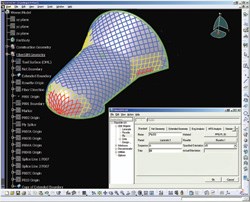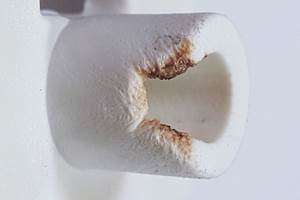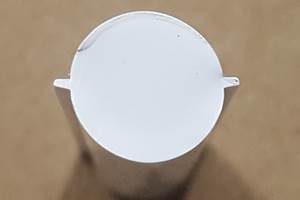New Software Aids Composite Processing and QC
Several recent software introductions for composites design, processing, and quality control offer more sophisticated predictions of both processability and finished part properties.
Several recent software introductions for composites design, processing, and quality control offer more sophisticated predictions of both processability and finished part properties. One new product actually controls the process. The new products can separate fiber failure from matrix failure when analyzing composite strength, optimize prepreg lay-up, control vacuum infusion molding, and verify fiber orientation before and after a part is molded.
Meet the Puck Criterion
The Institute for Plastics Processing (IKV) at the University of Aachen, Germany, was the first to develop software using the so-called Puck Criterion to analyze the load-bearing strength of composite structures. Strength analysis is complicated by the fact that the fibers and matrix resin fail at different points on the stress/strain curve.
The Puck Criterion analytical model is the first that can analyze the strength of fibers separately from the matrix polymer and calculate the inclination angle of a crack in the matrix. This allows a designer to change fiber orientation to correct a weakness. Before now, the Tsai/Wu Criterion has been the traditional analytical model, but it doesn’t distinguish between fiber and matrix failure. Introduced 18 months ago, the IKV’s software, called Compositor, is based on Microsoft’s Excel spreadsheet program. It costs a little over $1000, including a two-day training workshop.
Commercial software companies have implemented the Puck Criterion, too. Material SA in Zaventem, Belgium (represented in the U.S. by The Green Sales Guy Inc.), last year introduced similar software called Composite Star. It also analyzes the strength and stiffness of laminates and can predict the breaking point of different plies while distinguishing between fiber and matrix failure and the type of load causing failure—i.e., compression or shear. It also lets users decide whether a failure is critical or noncritical.
Composite Star complements finite-element analysis (FEA), looking in extreme detail at one point in a laminate structure. Typical FEA programs analyze the whole structure but are weak in identifying failure criteria within the laminate, according to Material SA. Composite Star costs around $1800.
Componeering Inc. in Helsinki, Finland, a four-year-old spinoff from the Helsinki University of Technology, also offers software to calculate composite strength with interfaces to FEA. The latest version of its ESAComp software introduces new formulations of the Puck Criterion. ESAComp starts at around $3600.
Fiber orientation analysis
Last year, MSC.Software Corp., maker of MSC.Nastran and MSC.Patran FEA software, introduced MSC.Robust Design software, which is believed to be the only stochastic design software on the market for composites. This means it allows random variations in ply thickness and angle to simulate real life tolerances and performance. Other software employing Design of Experiments (DOE) simulations can vary only one parameter at a time. Robust Design also includes a “Decision Tree” function that indicates which variables are more important.
This month, Vistagy is announcing a major upgrade: Version 5.0 of its FiberSIM software for composite lay-up. It integrates with commercial CAD programs, allowing engineers to design composite parts and simulate their manufacturability, showing how prepreg fabric conforms to curves and where splices and darts need to be inserted in the fabric to avoid wrinkles. The 5.0 upgrade is the first software anywhere that can create “variable laminate surface offsets,” Vistagy says, which means it can automatically stagger the overlap of different plies of fabric over complex curves by a variable amount. Previously engineers had to define each layer of fabric individually or the offsets had to be uniform.
VIP & RTM simulation
Polyworx, a seven-year-old software company in the Netherlands, brought out RTM-Worx software for simulating resin flow in RTM and vacuum infusion processes. It models resin flow in large parts like boat hulls, accounting for the effects of fiber orientation, permeability of the fabric stack, and the effects of gravity on resin flow. It predicts what will happen with specific locations of distribution channels and vacuum lines, allowing on-screen-trials. It also predicts how much resin is needed.
The Univ. of Delaware’s Center for Composite Materials commercialized its SMARTMolding software and hardware for controlling the SCRIMP vacuum infusion process with very large parts and multiple infusion lines. The new software is said to be the only program that can open and close infusion lines at the right time in the right order. Lines are typically opened and closed manually, but because infusion fabric fills quickly on the surface and more slowly underneath, adjusting flow by eye can be deceiving.
SMARTmolding automates parts of the infusion process, making it more repeatable—checking the vacuum bag for leaks, identifying fabric inserts with barcodes, verifying resin mixing, controlling infusion, and guiding an operator through the processing steps. Hardware includes valving, flow and vacuum sensors, and PLC touchscreen controls. Software and hardware together cost about $140,000.
High-tech QC
The Ultran Group (formerly Ultran Laboratories and SecondWave Systems) has a new ultrasonic array system called iPASS for quality control of composite parts. It uses patented non-contact transducers in an array that conforms to the part shape. This reportedly provides more detail and faster calculations when scanning a part to measure its thickness and detect porosity, delamination, holes, or cracks. It even senses fiber orientation. The iPASS system was introduced last year in prototype and was commercialized this year.
Assembly Guidance Systems introduced a hand-held automatic ply-verification (APV) device last year, called the High Accuracy Manually Positioned Inspector or HAMPI. It’s a camera-based system that inspects the top layer of fibers as a part is laid up, verifying orientation and creating a record of the inspection. HAMPI is used with the company’s laser guide system, which eliminates a physical template for positioning the plies. An operator clicks the laser-guide remote control and three laser dots appear on the part. The operator lines HAMPI up on those three dots and takes a picture. The dots align the picture with the stored CAD data on how the fiber plies should be oriented. HAMPI costs about $50,000 for the first unit and $20,000 for additional handheld units.
Related Content
Best Methods of Molding Undercuts
Producing plastics parts with undercuts presents distinct challenges for molders.
Read MoreBack to Basics on Mold Venting (Part 1)
Here’s what you need to know to improve the quality of your parts and to protect your molds.
Read MoreWhy Shoulder Bolts Are Too Important to Ignore (Part 1)
These humble but essential fasteners used in injection molds are known by various names and used for a number of purposes.
Read MoreWhere and How to Vent Injection Molds: Part 3
Questioning several “rules of thumb” about venting injection molds.
Read MoreRead Next
Processor Turns to AI to Help Keep Machines Humming
At captive processor McConkey, a new generation of artificial intelligence models, highlighted by ChatGPT, is helping it wade through the shortage of skilled labor and keep its production lines churning out good parts.
Read MorePeople 4.0 – How to Get Buy-In from Your Staff for Industry 4.0 Systems
Implementing a production monitoring system as the foundation of a ‘smart factory’ is about integrating people with new technology as much as it is about integrating machines and computers. Here are tips from a company that has gone through the process.
Read MoreAdvanced Recycling: Beyond Pyrolysis
Consumer-product brand owners increasingly see advanced chemical recycling as a necessary complement to mechanical recycling if they are to meet ambitious goals for a circular economy in the next decade. Dozens of technology providers are developing new technologies to overcome the limitations of existing pyrolysis methods and to commercialize various alternative approaches to chemical recycling of plastics.
Read More




























